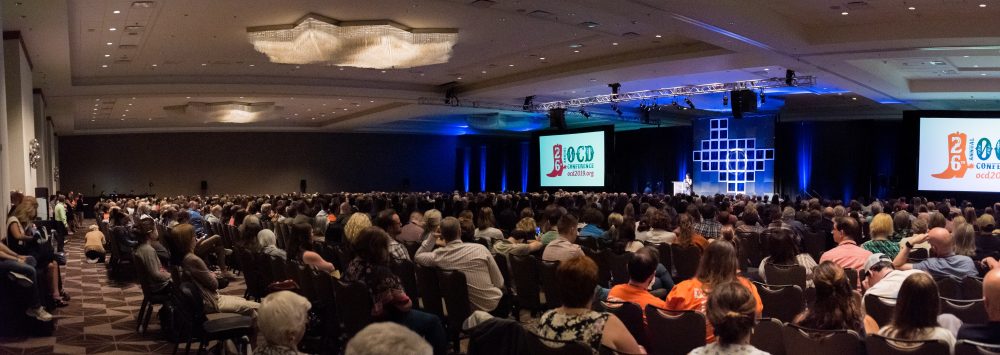By Vinay Krishnan, JD, IOCDF Diversity Advisory Council Member
I’m standing in a hotel banquet hall in San Francisco, and I’m thinking about something Mychal Denzel Smith wrote once, and I’m realizing that I might not actually be a monster.
Every summer, the International OCD Foundation (IOCDF) holds its annual Conference. The weekend brings together people living with OCD, family members of people living with OCD, physicians, researchers, artists, and many others to share stories, support one another, and to expand our understanding of this unique disorder. Each year, the Conference features research presentations, interactive workshops, art shows, social events, and support groups addressing the range of symptoms and challenges one could face while living with OCD.
I’ve attended the Conference for the last three years, first in San Francisco, then in D.C., and this past summer in Austin.
There’s one moment I look forward to every year. Without fail, it’s the most overwhelming moment of the Conference each time. It’s when I enter the room for the Keynote Address and find my seat. It doesn’t even matter who’s about to speak. It’s the room itself that moves me. It’s the space.
I remember the first time it happened, back in San Francisco in 2017. I stood in the back of the crowded hall for the presentation, as over 1,700 attendees trickled in and sat down. Throughout the weekend, everyone had been spread throughout the hotel, attending dozens of different lectures and seminars, without too many opportunities to interact as a group. This was the first time we were all in the same room, and my mind had trouble processing the scene.
I just couldn’t help but see the juxtaposition in my head. I kept cutting back to 15 years earlier, when I was a frightened high school kid, suffering in silence, convinced that I was the only one in the world with this particular set of symptoms. Surely nobody else was spending hours every night conjuring up these horrific irrational scenarios. Surely nobody else was obsessing about this. I’ve learned many times over how wrong I was about all that, objectively wrong. It’s something I’m secure with now intellectually, but emotionally, that sense of alienation never really leaves you. You always feel alone in the crowd, even if you’re the center of attention. You always feel misunderstood, even if you’re next to your closest friend. Standing in that hall, though, that feeling just — disappeared. It was gone, perhaps for the first time. What filled that void was something else entirely, a voice saying something completely foreign to me, something I immediately recognized as true, something everyone with a mental illness should hear: You belong in this world. You are okay as you are. You are not monstrous. I was part of a community, over 1,700 strong, who all understood what it means to see the world the way I do. We had created a space with no shame, and that changes everything.
I want that moment for other people. It’s not something any self-help book or therapy session can simulate. You have to stand there, see the faces, hear the voices, shake the hands. It’s something tangible.
But not everyone can stand in a room like that. Whether it’s affordability, access to care, criminalization, or cultural stigma, minorities often don’t get to sit in rooms like this. We don’t get to feel that fellowship. Very few people in that crowd looked like me. Almost nobody did. The demographic information collected by the IOCDF supports what I saw anecdotally.
Of the 1,491 people who filled out the demographic survey at the 2017 Conference, 14% identified as being a person of color. That number dropped to 11% in 2018 (of 1,401 people) and rose to 15% in 2019 (of 1,910 people). It’s important to keep in mind. though, that 295 people chose not to fill out the survey in 2017, 104 did in 2018, and 120 people did in 2019. It is certainly possible that many of these individuals were people of color who did not feel comfortable filling out a form that asked them to identify their race. Even a generous interpretation of this data, though, presents an IOCDF that can find better ways of reaching out to minorities living with OCD in the future, and doing so could have a positive effect on healthcare outcomes.
I first started dealing with OCD when I was 13, and I didn’t start seeing a therapist for it until I was 24. That’s 11 years without treatment, and that’s a common story for people at these conferences. People with mental illness often go years or decades or an entire lifetime without ever getting treatment for their illness.
This problem is even worse in minority communities. According to SAMHSA, 18.6% of Non-Hispanic Whites received mental health services in 2018, compared to 14.1% of American Indian/Alaska Natives, 10.9% of Native Hawaiin/Pacific Islanders, 8.8% of Hispanics/Latinos, 8.7% of Non-Hispanic African Americans, and 6.3% of Asian-Americans (National Survey on Drug Use and Health).
The barriers between minorities and effective mental health treatment are real. They’re cultural, they’re social, they’re economic.
One of the best recent articulations of this is an essay by Mychal Denzel Smith in Invisible Man, Got the Whole World Watching. Smith writes about having his first panic attack at age 16 and it being so incomprehensible to him that he did not even know how to articulate the problem to his parents as he cried in front of them. He grew up being similarly confused by bouts of depression, substance abuse, and by other panic attacks. He didn’t understand that he was mentally ill because he saw no examples of it in his life. Nobody in his community talked about mental illness. Smith writes, “I knew people who were locked up; I didn’t know anyone who was depressed. It was easy to forget.”
Smith describes growing up, repeatedly discounting his symptoms as individual events, not signs of illness. Panic attacks, depression. Losing interest in food, in school. Failing to go to class. “There was nothing to worry about,” he told himself over and over. “I could shake it off.”
“The more I lied, the more I wanted to believe the lie, the less I could. Every time I said I was fine, I saw myself dying.”
He first saw a discussion of black people and mental health from bell hooks, who wrote, “I have found myself saying again and again that mental health is the revolutionary antiracist frontier African Americans must collectively explore.” The writing changed his life.
What any good mental health advocate or organization should be doing — the IOCDF included — is giving people the opportunity to stand in the type of room I stood in. To see that they’re not alone. To make sure mental illness is not “easy to forget.” More than just spreading awareness or educating the public, we can help people reconceive how they see themselves, to reshape their own narrative, to encourage them to seek treatment, and to provide evidence that illness is not synonymous with weakness.
To confront these issues, the IOCDF has formed a Diversity Advisory Council. Here is our Mission Statement:
The mission of the IOCDF Diversity Initiative is to ensure that diverse, marginalized, and/or underrepresented populations are included in the OCD community at large. As a community, we seek to educate the public about diversity issues, increase community engagement, and facilitate access to care for diverse populations. We embrace all forms of diversity and provide a welcoming forum to exchange ideas and promote change.
Over the next five years, the Council aims to 1) create an IOCDF staff and leadership composition that reflects our diverse community at all levels, 2) increase the number of clinicians of color that are trained to treat OCD following best practices, 3) conduct outreach in minority communities to bring more people of color seeking OCD treatment into our community, 4) increase attendance and participation from minority communities at IOCDF events, and 5) increase online content that combats mental health stigma and changes the narrative that this is a white disorder.
Next year’s Conference will be held from July 31–August 2nd in Seattle. Here’s hoping we can create a more inclusive event and that we can use the conference — not as an isolated weekend — but as a springboard for transformative mental health work in minority communities.
I keep coming back to that room, what that felt like. Every time a prominent actor or athlete or writer speaks about their mental illness, they’re bringing more people into that room. They’re making it bigger. Every time we create safe spaces for mental health stories online or at open mics or at social events, we’re bringing more people into that room. We’re making it bigger. Hopefully, the Diversity Advisory Council can bring more people into that room and can increase access to care in the communities that need it the most.
Here’s the thing, though, and this is where the metaphor breaks down. We’re talking about rooms, about physical spaces, which inherently have limits, have walls. But that’s not how this works. There shouldn’t be a limit on this thing. Disability Justice isn’t about fitting more people into a room or checking an accessibility box. Access is the floor. It’s the bare minimum. It’s not the goal. The goal is dignity and respect and justice. The goal is stigma-free treatment for anyone who needs it.
Here’s hoping we can work towards providing that for all members of our community.
See you all in Seattle.


I too stood in that same room, but with a much different experience. I found myself angry, disappointed, and excluded. 1,721 was the exact number of attendees that was projected on the movie screen..I remember because I snapped a picture of it. I was angry because I didn’t see any classes (but one) design/geared towards people of color.. the only class was held in a back room tucked away from the main stream area, late class, and if memory serves me right it was on the last day of the conference. The class itself was wonderful, unfortunately besides myself and my husband, the facilitator and her therapist , a transgender person of color, one Hispanic girl, and a lost senior citizen of non color who elected to stay were the only attendees. I sat in that 15×15 room feeling rejected and devalued.. but I realize that I had to do more than complain about be mad. I wanted answers to why I only counted 16 persons of color at this so important and well organized conference..I talked/ met with some of the IOCDF staff. I am delighted to say that moment led me to becoming an advocate. I am so grateful to see steps being made to include and increase awareness and diversity … I will see y’all in Seattle ❤️Respectfully submitted
That was really inspiring. I’ve known all those feelings. I am one of those poor. hopefully i can make a conference one day soon. All my ocd compadres are wonderful giving people
At least you have clinics in America for kids with OCD , come to Australia where mental health for under 13’s is non existent and if you have OCD next to no help whatsoever . My son is 12 and has had OCD for just over a year and we only get a weekly visit from people who aren’t even trained in dealing with OCD . Complete joke our mental health system.